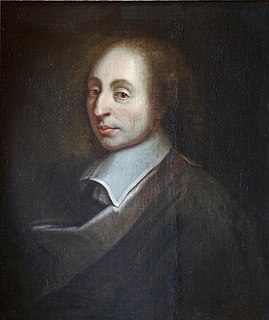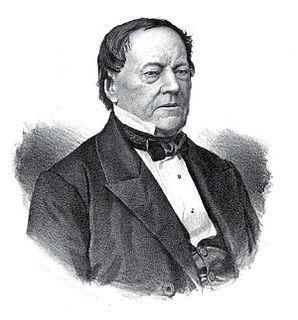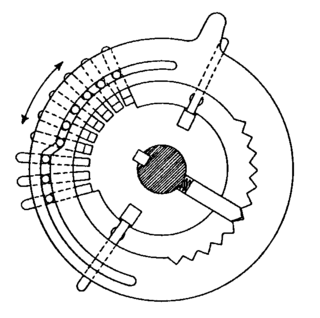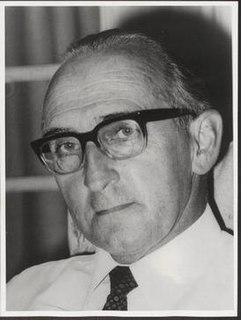Related Research Articles

Blaise Pascal was a French mathematician, physicist, inventor, philosopher, and Catholic writer.

An electronic calculator is typically a portable electronic device used to perform calculations, ranging from basic arithmetic to complex mathematics.

A difference engine is an automatic mechanical calculator designed to tabulate polynomial functions. It was designed in the 1820s, and was first created by Charles Babbage. The name, the difference engine, is derived from the method of divided differences, a way to interpolate or tabulate functions by using a small set of polynomial co-efficients. Some of the most common mathematical functions used in engineering, science and navigation, were, and still are computable with the use of the difference engine's capability of computing logarithmic and trigonometric functions, which can be approximated by polynomials, so a difference engine can compute many useful tables of numbers.

Wilhelm Schickard was a German professor of Hebrew and astronomy who became famous in the second part of the 20th century after Franz Hammer, a biographer of Johannes Kepler, claimed that the drawings of a calculating clock, predating the public release of Pascal's calculator by twenty years, had been discovered in two unknown letters written by Schickard to Johannes Kepler in 1623 and 1624.

The Comptometer was the first commercially successful key-driven mechanical calculator, patented in the United States by Dorr Felt in 1887.

A mechanical calculator, or calculating machine, is a mechanical device used to perform the basic operations of arithmetic automatically, or (historically) a simulation such as an analog computer or a slide rule. Most mechanical calculators were comparable in size to small desktop computers and have been rendered obsolete by the advent of the electronic calculator and the digital computer.

BESM-6 was a Soviet electronic computer of the BESM series. It was the first Soviet second-generation, transistor-based computer.

Pehr (Per) Georg Scheutz was a Swedish lawyer, translator, and inventor, who is now best known for his pioneering work in computer technology.

The arithmometer was the first digital mechanical calculator strong enough and reliable enough to be used daily in an office environment. This calculator could add and subtract two numbers directly and could perform long multiplications and divisions effectively by using a movable accumulator for the result.

Pascal's calculator is a mechanical calculator invented by Blaise Pascal in 1642. Pascal was led to develop a calculator by the laborious arithmetical calculations required by his father's work as the supervisor of taxes in Rouen. He designed the machine to add and subtract two numbers directly and to perform multiplication and division through repeated addition or subtraction.

A pinwheel calculator is a class of mechanical calculator described as early as 1685, and popular in the 19th and 20th century, calculating via wheels whose number of teeth were adjustable. These wheels, also called pinwheels, could be set by using a side lever which could expose anywhere from 0 to 9 teeth, and therefore when coupled to a counter they could, at each rotation, add a number from 0 to 9 to the result. By linking these wheels with carry mechanisms a new kind of calculator engine was invented. Turn the wheels one way and one performs an addition, the other way a subtraction.

The stepped reckoner or Leibniz calculator was a mechanical calculator invented by the German mathematician Gottfried Wilhelm Leibniz around 1672 and completed in 1694. The name comes from the translation of the German term for its operating mechanism, Staffelwalze, meaning "stepped drum". It was the first calculator that could perform all four arithmetic operations.

Allan George Bromley was an Australian historian of computing who became a world authority on many aspects of early computing and was one of the most avid collectors of mechanical calculators.

Amelia is a sentimental novel written by Henry Fielding and published in December 1751. It was the fourth and final novel written by Fielding, and it was printed in only one edition while the author was alive, although 5,000 copies were published of the first edition. Amelia follows the life of Amelia and Captain William Booth after they are married. It contains many allusions to classical literature and focuses on the theme of marriage and feminine intelligence, but Fielding's stance on gender issues cannot be determined because of the lack of authorial commentary discussing the matter. Although the novel received praise from many writers and critics, it received more criticism from Fielding's competition, possibly resulting from the "paper war" in which the author was involved.

A Leibniz wheel or stepped drum is a cylinder with a set of teeth of incremental lengths which, when coupled to a counting wheel, can be used in the calculating engine of a class of mechanical calculators. Invented by Leibniz in 1673, it was used for three centuries until the advent of the electronic calculator in the mid-1970s.

The Millionaire was the first commercially successful mechanical calculator that could perform a direct multiplication. It was in production from 1893 to 1935 with a total of about five thousand machines manufactured.

Bruno Baron von Freytag-Löringhoff was a German philosopher, mathematician and epistemologist. He was also a university lecturer at the University of Tübingen. During World War II, Freytag-Löringhoff worked as a mathematician in the In 7/VI, that was the signals intelligence agency of the Wehrmacht and worked with Fritz Menzer on the testing of cryptographic devices and procedures. Freytag-Löringhoff worked specifically on the testing of the m-40 cipher machine. His most important contributions to the history of logic and mathematics was his studies and descriptions from 1957, of the calculating machine, built by Wilhelm Schickard.
Peggy Aldrich Kidwell is an American historian of science, the curator of medicine and science at the National Museum of American History.
The History of Mathematical Tables: from Sumer to Spreadsheets is an edited volume in the history of mathematics on mathematical tables. It was edited by Martin Campbell-Kelly, Mary Croarken, Raymond Flood, and Eleanor Robson, developed out of the presentations at a conference on the subject organised in 2001 by the British Society for the History of Mathematics, and published in 2003 by the Oxford University Press.
References
- 1 2 3 4 5 6 7 8 Booth, A. D. (1993), "Review of The Calculating Machines", Mathematical Reviews and zbMATH, MR 1174086, Zbl 1066.01501
- 1 2 Tweedale, Geoffrey (March 1993), "Review of The Calculating Machines", The British Journal for the History of Science , 26 (1): 126–127, doi:10.1017/S0007087400030648, JSTOR 4027388
- 1 2 3 4 5 Swade, Doron (March 1994), "Review of The Calculating Machines", Isis , 85 (1): 136–137, doi:10.1086/356742, JSTOR 235911
- 1 2 3 4 "Review of The Calculating Machines", Bulletin of Science, Technology & Society , 13 (3): 182, June 1993, doi:10.1177/027046769301300399, S2CID 220737211
- 1 2 3 4 Golan, Jonathan Samuel (1992), "Review of The Calculating Machines", ACM Computing Reviews , ISBN 9780262132787